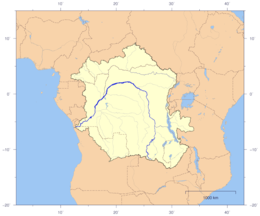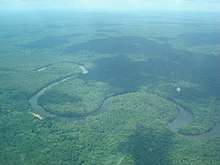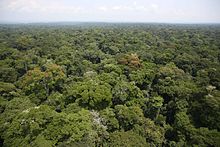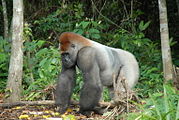
The Congo Basin (French: Bassin du Congo) is the sedimentary basin of the Congo River. The Congo Basin is located in Central Africa, in a region known as west equatorial Africa. The Congo Basin region is sometimes known simply as the Congo. It contains some of the largest tropical rainforests in the world and is an important source of water used in agriculture and energy generation.
The rainforest in the Congo Basin is the largest rainforest in Africa and second only to the Amazon rainforest in size, with 300 million hectares compared to the 800 million hectares in the Amazon. Because of its size and diversity the basin's forest is important for mitigating climate change in its role as a carbon sink. However, deforestation and degradation of the ecology by the impacts of climate change may increase stress on the forest ecosystem, in turn making the hydrology of the basin more variable. A 2012 study found that the variability in precipitation caused by climate change will negatively affect economic activity in the basin.
Eight sites of the Congo Basin are inscribed on the World Heritage List, five being also on the list of World Heritage in Danger (all five located in Democratic Republic of the Congo). Fourteen percent of the humid forest is designated as protected.
Geology
The Congo Basin is a large depression within the Congo Craton, making it a patch of relatively recent (Phanerozoic-aged, and mostly Mesozoic & onwards) sedimentary rock within a large, otherwise extremely ancient (Archean-aged) piece of exposed continental crust. The deformation of the Craton began as early as the late Cambrian or early Ordovician and continued over the Paleozoic, but the deformation over this period led to rapid erosion of much of this Paleozoic rock, creating a large unconformity. Sediment started to rapidly accumulate in the basin from the Mesozoic (Triassic) up to the present day.
Deposits throughout the Jurassic suggest the presence of a freshwater, lacustrine habitat in the basin, and this continued into the Early Cretaceous. By the start of the Late Cretaceous, a connection with the Trans-Saharan seaway led to a significant marine incursion into the basin (evidence of an earlier, Late Jurassic marine intrusion is disputed), causing it to serve as a connection between the southern Atlantic Ocean and the Tethys Ocean. Many of the formations deposited by these freshwater and marine habitats are rich in pollen, invertebrate, and vertebrate (primarily fish) fossils. Kimberlite pipes that are thought to have formed during the Cretaceous, possibly due to a shock from a sudden decrease in the rate of seafloor spreading of the southern Mid-Atlantic Ridge, are the source of the region's famous diamonds.
By the Cenozoic, an uplift in the borders of the Cuvette Centrale had blocked any further marine connections. During the Paleogene, high rainfall turned the basin into a series of marshy ponds and swamps. A shift to more arid conditions with seasonal droughts occurred with the start of the Neogene. Later in the Neogene, a sudden shift to fluvial deposits suggests a dramatic return to wetter conditions.
The following sedimentary geological formations have been deposited in the basin:
- Late Carboniferous/Permian - Lukuga Formation (part of the Lower Karoo)
- Early Triassic to Early Jurassic - Haute Lueki Formation (part of Upper Karoo)
- Late Jurassic - Stanleyville Formation
- Early Cretaceous - Loia Formation, Kamina Series
- Late Cretaceous - Bokungu Formation, Kwango Series (Nsele Group, Inzia Group)
- Paleogene - Kwango Formation, Kalahari System, Sables Bateke Series
- Neogene - Limons Series, Kalahari System, Sables Bateke Series
Description
See also: Congo River
Congo is a traditional name for the equatorial Middle Africa that lies between the Gulf of Guinea and the African Great Lakes. The basin begins in the highlands of the East African Rift system with input from the Chambeshi, the Uele and Ubangi rivers in the upper reaches and the Lualaba River draining wetlands in the middle reaches. Because of the young age and active uplift of the East African Rift at the headwaters, the river's yearly sediment load is very large, but the drainage basin occupies large areas of low relief throughout much of its area. It is delineated largely by swells including the Bie, Mayumbe, Adamlia, Nil-Congo, East African, and Zambian Swells.

The basin ends where the river empties into the Gulf of Guinea on the Atlantic Ocean. The basin is a total of 3.7 million square kilometers and is home to some of the largest undisturbed stands of tropical rainforest on the planet, in addition to large wetlands.
Countries wholly or partially in the Congo region:
- Angola
- Gabon
- Burundi
- Cameroon
- Central African Republic
- Democratic Republic of the Congo
- Republic of the Congo
- Tanzania
- Zambia
History
See also: Pre-colonial history of the Democratic Republic of the Congo, History of the Congo River, and Colonization of the Congo BasinThe first inhabitants of the Congo Basin area were believed to be pygmies, and at that time, the dense forests and wet climate kept the population of the region low, with the prevention of hunter-gatherer society, whose remnants of their culture survive to the present day. Eventually Bantu peoples migrated there and founded the Kingdom of Kongo.
Belgium, France, and Portugal later established colonial control over the entire region by the late 19th century. The General Act of the Berlin Conference of 1885 gave a precise definition to the "conventional basin" of the Congo, which included the entire actual basin plus some other areas. The General Act bound its signatories to neutrality within the conventional basin, but this was not respected during the First World War.
The World Resources Institute estimated that 80 million people live in and around the Congo Basin.

Climate
The Congo Basin is a globally important climatic region with annual rainfall of between 1500 and 2000 mm. It is one of three hotspots of deep convection (thunderstorms) in the tropics, the other two being over the Maritime continent and the Amazon. These three regions together drive the climate circulation of the tropics and beyond. The Congo Basin has the highest lightning strike frequency of anywhere on the planet. The high rainfall supports the second largest rainforest on Earth, which is a globally significant carbon sink and an important component of the global carbon cycle.
Averaged across the whole basin, there are two major rainfall seasons in March to May and September to November. In both hemispheres the rainfall maximises in September to November, at above 210 mm per month. In northern hemisphere winter, rainfall is relatively low to the north of the equator (<80 mm per month). In southern hemisphere winter, rainfall is instead lower to the south of the equator (<80 mm per month). The annual rhythm of the wind systems which carry water vapour account for the rainfall seasonality. Much of the rainfall is derived from large Mesoscale convective systems. The systems last over 11 hours on average and have a mean size exceeding 500 km2 in some parts of the Congo Basin.

Temperatures in the Congo Basin (usually between 20 and 30 °C) are lower than in the African desert regions to the north (The Sahara) and to the south (Kalahari). The differences in temperature between the deserts and the Congo Basin is important for driving wind systems known as African easterly jets, which affect climate and weather in the Sahel and Southern Africa.
Future climate projections indicate that the region will get hotter in response to global climate change. There is more uncertainty over how average rainfall in the region will change, with the climate models used by the Intergovernmental Panel on Climate Change (IPCC) disagreeing on core elements of the rainfall distribution in the region. While the average rainfall change is uncertain, it is likely that extreme rainfall events will become more extreme owing to the increases in water vapour in the atmosphere.
Owing to the global climatic importance of the Congo Basin, it has been suggested that, along with the Amazon, severe changes in the rainfall or climate of the Congo Rainforest could act as a 'tipping point', with widespread impacts on the Earth System.
Flora and fauna
The Congo forest is home to the okapi, African forest elephant, pygmy hippopotamus, bongo (antelope), chimpanzee, bonobo and the Congo peafowl. Its apex predator is the Leopard, which are larger than their savannah counterparts due to lack of competition from other large predators. The basin is home to the endangered western lowland gorilla. In 2010, the United Nations Environment Programme warned that gorillas could be extinct from the greater Congo Basin in a matter of 15 years.

The Congo Basin is the largest forest in Africa. More than 10,000 plant species can be found in and around the forest. The humid forests cover 1.6 million km². The Congo Basin is an important source of African teak, used for building furniture and flooring. An estimated 40 million people depend on these woodlands, surviving on traditional livelihoods.
Ecology and protection
See also: Congo Basin Forest Partnership and Deforestation in the Democratic Republic of the CongoAt a global level, Congo's forests act as the planet's second lung, counterpart to the rapidly dwindling Amazon. They are a huge "carbon sink", trapping carbon that could otherwise remain carbon dioxide. The Congo Basin holds roughly 8% of the world's forest-based carbon. If these woodlands are deforested, the carbon they trap will be released into the atmosphere. Predictions for future unabated deforestation estimate that by 2050 activities in the DRC will release roughly the same amount of carbon dioxide as the United Kingdom has emitted over the last 60 years. A 2013 study by British scientists showed that deforestation in the Congo Basin rainforest was slowing down. In 2017, British scientists discovered that peatlands in the Cuvette Centrale, which cover a total of 145,500 sq km, contain 30 billion tonnes of carbon, or 20 years of U.S. fossil fuel emissions. In 2021, the deforestation rate of the Congolese rainforest increased by 5%.

The Global Forest Atlas estimated that the logging industry covers from 44 to 66 million hectares of forest. A study published in 2019 in Nature Sustainability showed that 54,000 miles of roads for forest concessions were built between 2003 and 2018, reaching a total of 143,500 miles. A moratorium on logging in the Congo forest was agreed between the World Bank and the Democratic Republic of the Congo in May 2002. The World Bank agreed to provide $90 million of development aid to Democratic Republic of the Congo with the provision that the government did not issue any new concessions granting logging companies rights to exploit the forest. The deal also prohibited the renewal of existing concessions.
The government has written a new forestry code that requires companies to invest in local development and follow a sustainable, 25-year cycle of rotational logging. When a company is granted a concession from the central government to log in Congo, it must sign an agreement with the local chiefs and hereditary land owners, who give permission for it to extract the trees in return for development packages. In theory, the companies must pay the government nearly $18 million rent per year for these concessions, of which 40% should be returned to provincial governments for investment in social development of the local population in the logged areas.
In its current form, the Kyoto Protocol does not reward so-called "avoided deforestation"—initiatives that protect forest from being cut down. But many climate scientists and policymakers hope that negotiations for Kyoto's successor will include such measures. If this were the case, there could be a financial incentive for protecting forests. L’Île Mbiye, an island in the Lualaba River in Kisangani, is part of a project about forest ecosystem conservation, conducted by Stellenbosch University. Democratic Republic of the Congo is also looking to expand the area of forest under protection, for which it hopes to secure compensation through emerging markets for forest carbon. The main Congolese environmental organization working to save the forests is an NGO called OCEAN, which serves as the link between international outfits like Greenpeace and local community groups in the concessions.
National parks
- Lobéké National Park
- Lomami National Park
- Nouabalé-Ndoki National Park
- Ntokou-Pikounda National Park
- Odzala-Kokoua National Park
- Salonga National Park
- Virunga National Park
- Garamba National Park
- Kundelungu National Park
- Kahuzi-Biega National Park
- Upemba National Park
- Maiko National Park
References
- ^ "Climate Change Impacts on the Congo Basin Region". WUR. 2012-09-28. Retrieved 2021-09-20.
- The State of Forests in the Amazon basin and Southeast Asian (PDF). Brazzaville, Republic of Congo: Food and Agriculture Organization of the United Nations (FOA). ISBN 978-92-5-106888-5. Retrieved 14 April 2012.
- ^ "The Congo Rainforest Is Losing Ability to Absorb Carbon Dioxide. That's Bad for Climate Change". Pulitzer Center. Retrieved 2021-09-20.
- ^ "Natural World Heritage in the Congo Basin". UNESCO World Heritage Centre. Retrieved 2021-05-13.
- ^ Giresse, Pierre (2005-10-01). "Mesozoic–Cenozoic history of the Congo Basin". Journal of African Earth Sciences. Phanerozoic Evolution of Africa. 43 (1): 301–315. doi:10.1016/j.jafrearsci.2005.07.009. ISSN 1464-343X.
- Caillaud, Alexis; Blanpied, Christian; Delvaux, Damien (2017-08-01). "The Upper Jurassic Stanleyville Group of the eastern Congo Basin: An example of perennial lacustrine system". Journal of African Earth Sciences. 132: 80–98. doi:10.1016/j.jafrearsci.2017.05.002. ISSN 1464-343X.
- Nkere, Buliba J.; Griffin, William L.; Janney, Philip E. (2019-09-01). "Emplacement age of the Tshibwe kimberlite, Democratic Republic of Congo, by in-situ LAM-ICPMS U/Pb dating of groundmass perovskite". Journal of African Earth Sciences. 157: 103502. doi:10.1016/j.jafrearsci.2019.05.010. ISSN 1464-343X.
- Mineral deposits & Earth evolution. Geological Society. 2005. ISBN 978-1-86239-182-6.
- Kadima, E.; Delvaux, D.; Sebagenzi, S. N.; Tack, L.; Kabeya, S. M. (2011). "Structure and geological history of the Congo Basin: an integrated interpretation of gravity, magnetic and reflection seismic data". Basin Research. 23 (5): 499–527. Bibcode:2011BasR...23..499K. doi:10.1111/j.1365-2117.2011.00500.x. ISSN 1365-2117. S2CID 53587215.
- ^ "You can't spell Congo without NGO". Africa Reports. 2021-02-28. Retrieved 2021-05-13.
- Albrecht, R. I., S. J. Goodman, D. E. Buechler, R. J. Blakeslee, and H. J. Christian, 2016: Where Are the Lightning Hotspots on Earth?. Bull. Amer. Meteor. Soc., 97, 2051–2068, https://doi.org/10.1175/BAMS-D-14-00193.1.
- Dargie, Greta C., et al. "Age, extent and carbon storage of the central Congo Basin peatland complex." Nature 542.7639 (2017): 86-90.
- ^ Jackson, B., S. E. Nicholson, and D. Klotter, 2009: Mesoscale Convective Systems over Western Equatorial Africa and Their Relationship to Large-Scale Circulation. Mon. Wea. Rev., 137, 1272–1294, https://doi.org/10.1175/2008MWR2525.1.
- Thorncroft, C.D. and Blackburn, M. (1999), Maintenance of the African easterly jet. Q.J.R. Meteorol. Soc., 125: 763-786. https://doi.org/10.1002/qj.49712555502
- IPCC AR6 2022
- Creese, A., Washington, R., & Munday, C. (2019). The plausibility of September–November Congo Basin rainfall change in coupled climate models. Journal of Geophysical Research: Atmospheres, 124, 5822– 5846. https://doi.org/10.1029/2018JD029847
- Garcin, Y. et al. (2022) Hydroclimatic vulnerability of peat carbon in the central Congo Basin, Nature, doi:10.1038/s41586-022-05389-3
- "Deforestation in Africa's Congo Basin rainforest slows". BBC News. 2013-07-22. Retrieved 2021-05-13.
- "World's largest tropical peatland found in Congo basin". the Guardian. 2017-01-11. Retrieved 2021-05-13.
- Weston, Phoebe (2020-02-28). "Plan to drain Congo peat bog for oil could release vast amount of carbon". The Guardian. Retrieved 2022-04-23.
- "Analysis: The next Amazon? Congo Basin faces rising deforestation threat". Reuters. 11 November 2022.
- Kinver, Mark (2019-09-12). "World 'losing battle against deforestation'". BBC News.
- "Logging road construction has surged in the Congo Basin since 2003". Mongabay Environmental News. 2019-06-24. Retrieved 2021-05-13.
- "The Fight to Save Congo's Forests". thenation.com. October 22, 2007.
External links
- Pygmies.org: African Pygmies website — first inhabitants of the Congo Basin rainforests.
0°00′00″N 22°00′00″E / 0.0000°N 22.0000°E / 0.0000; 22.0000
Categories:- Congo drainage basin
- Congo River
- Drainage basins of Africa
- Sedimentary basins of Africa
- Regions of Africa
- Congolian forests
- Landforms of Angola
- Landforms of Cameroon
- Geography of Central Africa
- Landforms of Burundi
- Landforms of Rwanda
- Landforms of Tanzania
- Landforms of the Central African Republic
- Landforms of the Democratic Republic of the Congo
- Landforms of the Republic of the Congo
- Landforms of Zambia
- Basins of Africa

